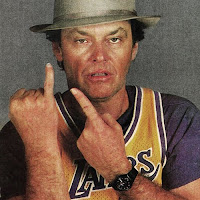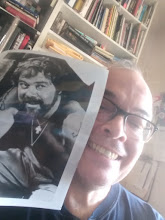
Drive, He Said
Directed by Jack Nicholson
Screenplay by Jack Nicholson and Jeremy Larner (and Robert Towne and Terrence Malick, uncredited)
Based on the novel by Jeremy Larner
Never released to VHS, and rarely screened theatrically (I caught it in the mid-1980s as it played for one day at the old Thalia (RIP) on a double-bill with Head!),
Drive, He Said is finally available on DVD after being “missing” for decades!

(Nicholson near Otto Mannix’s roof, circa 1970) After Easy Rider put him on the map, but before Five Easy Pieces made him a STAR, Jack Nicholson was given the opportunity to direct a film by BBS/Columbia—
After Easy Rider put him on the map, but before Five Easy Pieces made him a STAR, Jack Nicholson was given the opportunity to direct a film by BBS/Columbia—
Nicholson had already written The Trip for Corman/AIP, and co-written and produced the infamous Head (also for BBS; BTW, Jack also produced the awesome Head soundtrack album), so giving him the directorial reins wasn’t just a case of satisfying a star’s ego—and Drive, He Said is a technically perfect movie, with superior camerawork (the basketball scenes are especially impressive—not surprising considering Nicholson’s love of the game).
is a technically perfect movie, with superior camerawork (the basketball scenes are especially impressive—not surprising considering Nicholson’s love of the game).
Interestingly, BBS did not impose a rule that Nicholson had to also appear in his film. Had I run BBS, I would’ve demanded it! (Unless they were worried about the first-time director being overwhelmed.)
But Drive, He Said is crammed with too much:
I got the impression that Nicholson knew that this was his last chance at something extremely personal and creative (before being absorbed into The Big Hollywood Dream Machine—he had worked too long and hard, and just knew The Big Time was around the corner), and he wanted to get as many ideas and themes in as he could—and proceeded to bite off more than he could chew. There are references to such diverse esoteric knowledge as Wilhelm Reich, Rudyard Kipling, and the guerilla street theater movement.
There are references to such diverse esoteric knowledge as Wilhelm Reich, Rudyard Kipling, and the guerilla street theater movement.
Heck, the film’s main music theme is by Moondog! This ain’t mainstream, man!
SYNOPSIS:
At an unnamed college in Ohio (but actually filmed at the University of Oregon, Eugene—hey, isn’t that where they filmed Animal House?),
Hector is the star basketball player—but lately Hector hasn’t been giving a shit about anything, to the complete annoyance of hard-driving coach Bruce Dern,
not even the affair he’s been having with Karen Black, the wife of one of his professors
(played by screenwriter—and Pomona College graduate! Go Sagehens! Chirp!—Robert Towne; looking very stoned in Drive, He Said, I must say). Hector’s theater-major roommate, meanwhile, hasn’t slept in two weeks so he can fail his draft board exam.
Hector’s theater-major roommate, meanwhile, hasn’t slept in two weeks so he can fail his draft board exam.
The annoyance that is Hector’s roommate succeeds too well, and goes completely mad.
Yeah, that’s about it.
(Actually, I was surprised that the autodidact Nicholson set his film at a college campus—a sop to the “youth market,” perhaps? He might have done better making a flick about high school seniors instead.) The film lists four (!) editors in its credits, so you know Nicholson & crew shot a TON of footage (one editor alone must have been needed for the b-ball coverage)—which then had to be turned into something coherent, and then made into a manageable length of roughly 90 minutes in order to “sell” it.
The film lists four (!) editors in its credits, so you know Nicholson & crew shot a TON of footage (one editor alone must have been needed for the b-ball coverage)—which then had to be turned into something coherent, and then made into a manageable length of roughly 90 minutes in order to “sell” it.
And I think it was some of the slower, quieter scenes of characterization that were cut: We’re dropped right into the midst of things—which isn’t necessarily bad; it can make for some exciting viewing, and a disjointed time-structure would not have been out of place in this picture, especially if it had made things more interesting or coherent—but we are introduced to characters, especially the basketball player’s roommate, in medias res: we see them AFTER they’ve already flipped out, so we have no basis of comparison.
we see them AFTER they’ve already flipped out, so we have no basis of comparison.
It’s just “there’s a crazy person acting crazy”—and why should we care?
Nicholson would have done better to focus primarily on the basketball player and his relationships with his asshole coach (a stand-out Bruce Dern) and Karen Black, excellent, but not given enough to do other than react to the crazy men surrounding her. Peter Hanson at Every 70s Movie has an interesting theory about Drive, He Said.
Peter Hanson at Every 70s Movie has an interesting theory about Drive, He Said.
Hanson writes about seeing Nicholson speaking after a screening of Chinatown a few years ago:
“Not having heard Nicholson speak extemporaneously before, I was surprised by how erudite he was but also by how obtuse he was. Though clearly steeped in esoteric artistic theories, he wasn’t particularly good at getting his ideas across. Perhaps that’s why he’s thrived as an actor, using other people’s writing as a prism for focusing his intellect. And perhaps that’s why he hasn’t thrived as a director, despite having helmed three features thus far. Each of Nicholson’s directorial efforts contains interesting ideas, but all are aesthetic and narrative jumbles.” [Nicholson’s other directorial efforts, so far, have been Going South (1979), a quasi-romantic comedy Western (featuring John Belushi as a Mexican bandit in tribute to Gold Hat in The Treasure of Sierra Madre); and The Two Jakes (1990), an ill-advised attempt at a Chinatown sequel.]
[Nicholson’s other directorial efforts, so far, have been Going South (1979), a quasi-romantic comedy Western (featuring John Belushi as a Mexican bandit in tribute to Gold Hat in The Treasure of Sierra Madre); and The Two Jakes (1990), an ill-advised attempt at a Chinatown sequel.]
However, if you’re interested in the experimental (and often overly self-indulgent) films of the late-60s/early-70s “New American Cinema,” (see Ashby, Jaglom, Altman, et al) or are interested in “fascinating failures” (ditto), Drive, He Said is worth a look.
Now, why the FUCK is there graffiti in the movie that says “HD Stanton”? (see framegrab below; look to the right)
Is this a shout-out to our beloved Harry Dean—a longtime pal of The Jack?
Here’s a funny story: Nicholson had been kicked out by his first wife and needed a place to stay.
Stanton had been living in the Valley for about six months, and said Nicholson could crash over.
Nicholson arrives—
and is shocked to see that Stanton, living there for almost half a year, still has not unpacked.















No comments:
Post a Comment